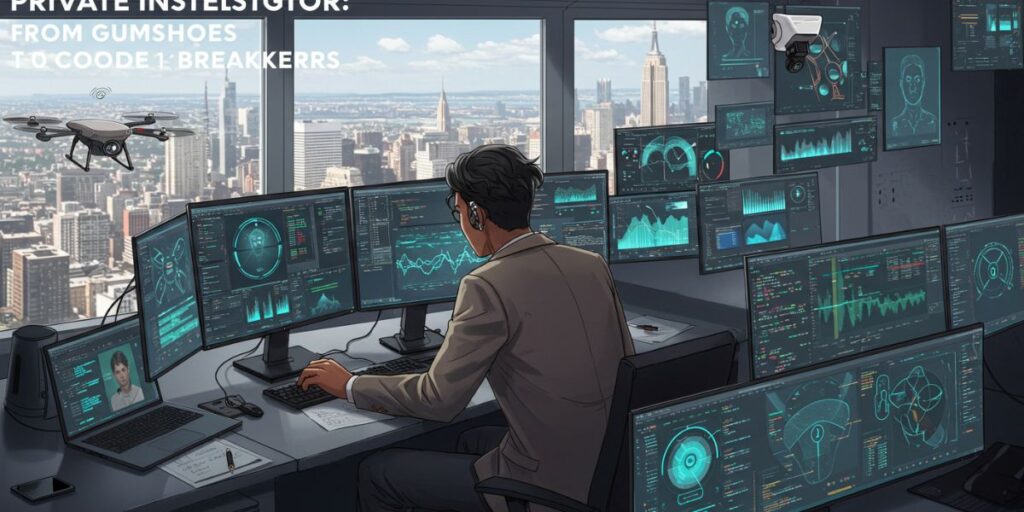
So, What Exactly Is an AI Private Investigator?

Imagine this: You’re being followed—but not by a trench coat-wearing guy with a camera. It’s software. Algorithms. Invisible eyes are sorting data faster than you can blink. That’s the AI private investigator.
At its core, this digital sleuth isn’t some humanoid robot knocking on doors. It’s a sophisticated blend of machine learning models, computer vision, natural language processing, and predictive algorithms all rolled into one tireless, logic-driven engine. It gathers, analyzes, and interprets data—from texts and emails to CCTV footage and social media footprints—at a speed and scale no human PI could ever match.
Keyword Focus: AI detective, artificial intelligence in private investigation
And no, it doesn’t forget details, miss sleep, or get emotionally involved. That’s part of its appeal—and part of what makes it a bit scary, too.
From Gumshoes to Algorithms: A Brief History of Private Investigation
Let’s rewind for a second.
Private investigation used to be all about instinct, charm, and persistence. The classic image? A chain-smoking PI tailing cheating spouses or wiretapping shady businessmen. Think noir films—gritty monologues, rain-slicked streets, and lots of peeking through blinds.
But as tech started reshaping society, PIs evolved too. Hidden cameras shrank. Wiretaps became phone cloning. Public records went digital. And suddenly, the legwork was more like keyboard work.
Then came the real shift: machine learning. Once basic surveillance crossed paths with AI, the game changed. Dramatically.
When AI Crashed the Investigation Scene
There wasn’t just one moment when artificial intelligence barged in—it sort of crept up.
First, we had simple automation: facial recognition at airports, predictive crime maps, and spam filtering in emails. Then came smarter tools—AI models trained to identify suspicious behavior in financial transactions or spot inconsistencies in testimonies during interviews.
By the late 2010s, law enforcement and security agencies had started dipping their toes in deeper. Cities like London and Chicago were testing AI-driven camera systems. The NYPD used software to scan social media for threats. And companies like Palantir started offering analytics platforms to governments.
Early adopters in surveillance and law enforcement paved the way for what we now call AI private investigators. And the private sector? They weren’t far behind.
What’s in the toolkit? AI Surveillance Tools You Should Know
Okay, let’s get technical for a minute—but we’ll keep it chill.
- Facial Recognition
Ever wonder how Facebook tags your friends automatically? That’s facial recognition in action. Now imagine that on steroids, cross-referencing you across traffic cams, building entrances, and airport gates. - Predictive Policing
Sounds futuristic, right? But it’s already happening. AI crunches historical crime data to predict where crimes are likely to happen. Think of it as Minority Report… minus Tom Cruise. - Natural Language Processing (NLP)
This one’s slick. NLP tools can “listen” to interviews or read thousands of texts and flag inconsistencies, emotional shifts, or even lies. It’s not foolproof—but it’s faster than a detective skimming transcripts.
Keyword Focus: AI surveillance tools, machine learning in investigation
And those tools? They’re just the beginning. Some systems can identify walking patterns (gait analysis), track voice tone changes over time, or even scan for emotional distress in video calls. Creepy? Maybe. Powerful? Absolutely.
Digital Forensics, But Smarter: How AI Upgrades the Process

Now we’re in the thick of it—digital forensics.
Think about how much of your life leaves a digital footprint: texts, emails, app logs, GPS data, fitness tracker records. Sorting through all that manually? A nightmare. But AI doesn’t mind messy data—it thrives on it.
AI-enhanced tools can:
- Reconstruct timelines from metadata
- Detect altered or deleted files
- Analyze relationships between people based on message patterns
A great example? There was a cyberstalking case where AI flagged unusual location check-ins across multiple social media accounts. Turns out, one suspect had created fake profiles to track their target. Old-school PIs might’ve taken months to piece that together—AI did it in hours.
And don’t even get us started on deepfake detection. That’s a whole other layer where AI battles AI. More on that later.
Playing with Fire: Legal and Ethical Minefields
Let’s slow down for a second.
All this tech sounds thrilling—and, yeah, a bit like sci-fi—but it raises some big ethical questions. Like:
- Who owns the data?
- What’s considered consent in digital surveillance?
- When does ‘investigating’ become ‘invading’?
Keyword Focus: AI ethics, data privacy, AI
Privacy laws vary wildly across regions. In the EU, GDPR draws hard lines about consent and data handling. But in the U.S.? Things are…looser, especially when you factor in third-party data brokers.
There’s also the issue of bias. If AI systems are trained on flawed or biased data, they’ll replicate those biases—maybe even amplify them. Facial recognition software has come under fire for misidentifying people of color, especially in law enforcement contexts.
So yeah—AI might be a genius-level assistant. But without ethical guardrails? It’s playing detective, judge, and jury all at once. Not a great combo.
So, What’s Next? The Future of AI in Private Investigation
Alright, now for the juicy part: where is all this going?
Here’s a peek into what’s coming down the tech pipeline:
- Predictive Analysis 2.0
Not just where crimes might happen, but who’s likely to be involved. Risk scoring is already in use in insurance and credit. Law enforcement might not be far behind. - Autonomous Tracking Systems
Think drones with AI that can follow a person across a city, adjusting based on foot traffic, weather, or disguises. No, seriously—it’s being tested. - Deepfake Detection Arms Race
As deepfakes get better, AI tools are being trained to detect eye movement, lighting inconsistencies, and audio mismatches. It’s a constant cat-and-mouse game. - Generative AI for Surveillance
This one’s wild: AI that doesn’t just analyze footage, but fills in the blanks. Say, generating hypothetical conversations based on behavior patterns or constructing possible timelines when data is missing.
There’s even talk about using AI to simulate human intuition, teaching it how to “feel” suspicious behavior. Yeah, it sounds like sci-fi. But then again, so did facial recognition a decade ago.

Final Thoughts: Man vs. Machine—or Team-Up?
Here’s the thing.
AI isn’t here to replace private investigators. Not entirely, anyway. But it is changing how they work—fast. Instead of spending hours tailing suspects or scouring paper trails, a PI might spend more time analyzing AI-generated leads and interpreting patterns.
You know what? Maybe that’s a good thing. Less grunt work. More insight. Fewer car chases.
But the real question isn’t whether AI can investigate. It’s whether we can keep up with the tech, the ethics, and the choices it forces us to make. Because once you teach a machine how to be suspicious… it doesn’t unlearn it.